Vehicle Crash Safety Facility Performance Test
Safety barrier
Safety barrier
- A. Rigidity Performance Evaluation Test Conditions
강도성능 평가 시험조건에 대한 표로써 등급, 충돌속도, 차량중량, 충돌각도, 기준충격도 항목으로 구성됩니다. Rating Impact Velocity (km/h) Vehicle Weight (kg) Impact Angle (°) Standard Impact Severity (kJ) SB1 55 8,000 15 60 SB2 65 90 SB3 80 130 SB3-B 85 150 SB4 65 14,000 160 SB5 80 230 SB5-B 85 270 SB6 80 25,000 420 SB7 36,000 600 ※ Footnote) SB: Safety Barrier - B. Passenger Protection Performance Test Conditions
탑승자 보호성능 평가 시험조건에 대한 표로써 등급, 충돌속도, 차량중량, 충돌각도 항목으로 구성됩니다. Rating Impact Velocity (km/h) Vehicle Weight (kg) Impact Angle (°) SB1 60 900 주) 1,300 20 SB2, SB4 80 SB3 100 SB5, SB6, SB7 SB3-B, SB5-B 120 ※ Footnote) 900kg passenger vehicle test recommended, conduct test with 1,300kg passenger vehicle until there is sufficient research, 1,300kg passenger vehicle test not necessary for facilities that pass 900kg passenger vehicle test
Crash Barrier Impact Point and Direction
-
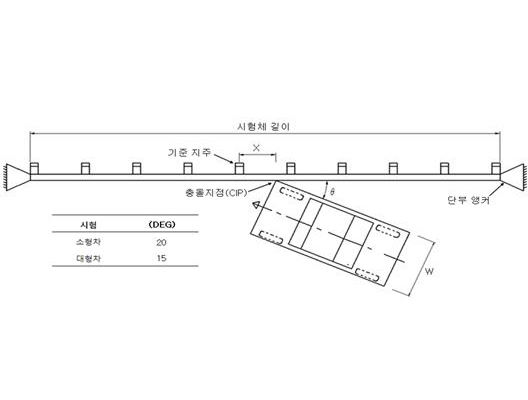 Crash Barrier Impact Point and Direction
Crash Barrier Impact Point and Direction
-
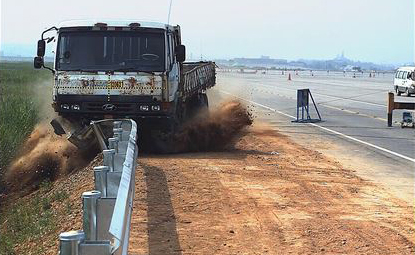 A crash barrier for roadside
A crash barrier for roadside
-
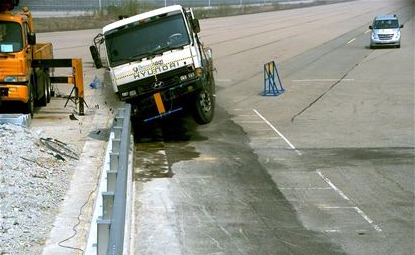 A crash barrier for bridge
A crash barrier for bridge
-
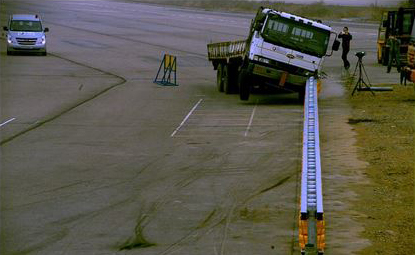 A crash barrier for company
A crash barrier for company
-
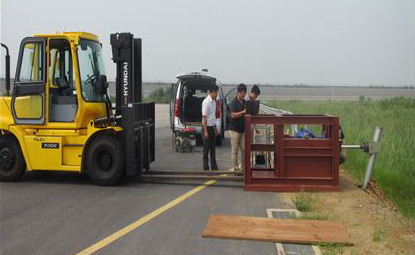 Strut Horizontal Bearing Teste
Strut Horizontal Bearing Teste
- C. Performance Evaluation Standards
성능평가 기준에 대한 표로써 측정항목, 기준 항목으로 구성됩니다. Measured Items Standards Rigidity performance evaluation impact test Structure performance Crash barrier rigidity performance Maintain rigidity Crash barrier deformity performance Maximum distance of impact deformity is below 1.0m (Within soil), below 0.3mm (Within concrete) Composition material shatter resistance performance능 Composition material shall not shatter onto the road or outside of the road and inflict damage to passenger or a third party Vehicle behavior after impact No vehicle overturn, etc. Vehicle center of mass shall not cross the center line of crash barrier Trajectory of crashed vehicle shall not cross the line B of bugout box
Footnote) Definition of Bugout Box A and B

| Vehicle Type | A(m) | B(m) |
|---|---|---|
| Car / Pickup | 2.2+Vw+0.16VL | 10.0 |
| Other vehicles | 4.4+Vw+0.16VL | 20.0 |
※ Vw: Vehicle width, VL: Vehicle length
| Measured Items | Standards |
|---|---|
| Passenger protection performance evaluation impact test | |
| Passenger protection performance | THIV: Below 33km/h |
| PHD: Below 20g | |
| ASI (Reference value) | |
| Composition material shall not shatter onto the road or outside of the road and inflict damage to passenger or a third party | |
| Vehicle internal space deformity (Rooftop: Below 100mm, Front: Below 75mm, Front door: Below 230mm, Impact side window: Not destroyed) | |
| Vehicle behavior after impact | No vehicle overturn, etc. |
| Rotation angle of roll and pitch are below 75° | |
| Trajectory of crashed vehicle shall not cross the line B of bugout box | |
※ THIV: Theoretical Head Impact Velocity
※ PHD: Post-impact Head Deceleration
※ ASI: Acceleration Severity Index
Transition Zone
- A. Performance evaluation for transition zone is equivalent to main line zone of crash barrier
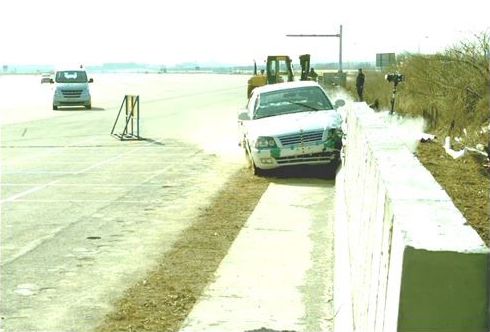
Transition zone vehicle test
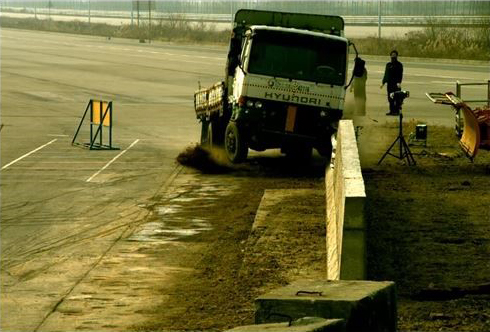

Transition zone truck test
- B. Conditions of impact test for transition zone
Impact points of transition zone shall be at 1/4 of entire transition zone length for crash barrier with high rigidity for small vehicle test and 1/2 of entire transition zone length for large vehicle test.
Transition Zone Full Scale Crash Test Impact Point
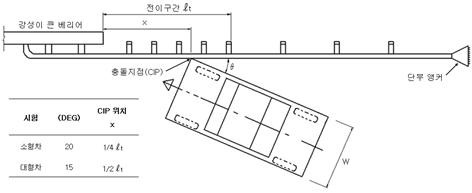
End Treatment
- A. Performance Test Conditions
단부처리시설 성능시험 조건에 대한 표로써 시험등급, 충돌속도, 차량중량, 충돌방법, 충돌방향 항목으로 구성됩니다. Test Rating Impact velocity (km/h) Vehicle weight (kg) Collision method Collision direction ET1 60 1,300 Test ① Head-on collision (Facility center) Test ② Side 15° collision Test ③ Side 165° collision ET2 80 1,300 Test ① Head-on collision (Facility center) Test ② Side 15° collision Test ③ Side 165° collision ET3 100 1,300 Test ① Head-on collision (Facility center) Test ② Side 15° collision Test ③ Side 165° collision ※ Footnote) 1. ET - End Treatment2. Test ③ must be performed for end treatment installed at median and Test ③ shall be omitted for roadside and bridge crash barriers. However, Test ③ shall be performed for zone where driving vehicle may cross the center line into vehicle running in opposite direction. For end treatment installed in curve shape, Test ③ shall be omitted when the angle between tangent of impact point of Test ③ and direction of progress is below 5°.
Impact Position and Direction for Crash Vehicle
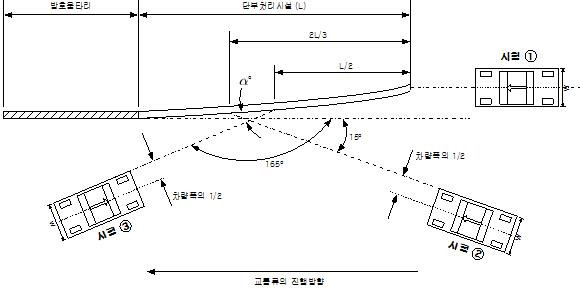
- B. Performance Evaluation Standards
충돌차량의 충돌위치 성능평가 기준에 대한 표로써 측정항목, 기 준 항목으로 구성됩니다. Measured Items Standards Passenger Protection Function Theoretical Head Impact Velocity (THIV) ≤44km/h (Test ①)≤33km/h (Tests ②,③) Post-impact Head Deceleration (PHD) ≤20g ASI (Reference value) Composition material shall not enter inside the vehicle Deformity within internal space of vehicle shall be limited as below
- Rooftop: Below 100mm
- Windshield: Below 75mm (Does not shatter from direct contact with facility)
- Front door (Side): Below 230mm (Does not shatter from direct contact with facility)End treatment behavior Composition material does not scatter onto the road or outside of the road Missile above individual weight of 2kg does not scatter beyond 2m from the front side of crash test object Vehicle behavior after impact Vehicle shall be standing on the ground surface after impact Vehicle does not suddenly stop or turn over after impact in Tests ② and ③ ※ THIV : Theoretical Head Impact Velocity ※ PHD : Post-impact Head Deceleration ※ ASI : Acceleration Severity Index -
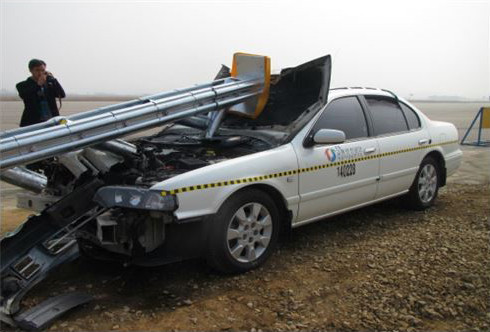
Roadside end treatment
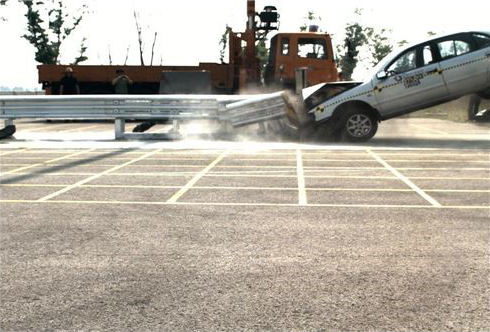
Median end treatment
Shock Absorber
- A. Performance Test Conditions
충격흡수시설 성능시험 조건에 대한 표로써 등급, 충돌속도, 차량중량, 충돌방법 항목으로 구성됩니다. Rating Impact velocity (km/h) Vehicle weight (kg) Collision method CC1 60 900 Test ① 1,300 Test ④ CC2 80 900 Test ① 1,300 Test ① 900 Test ② 1,300 Test ③ 1,300 Test ④ 1,300 Test ⑤ CC3 100 900 Test ① 1,300 Test ① 900 Test ② 1,300 Test ③ 1,300 Test ④ 1,300 Test ⑤ CC4 120 900 Test ① 1,300 Test ① 900 Test ② 1,300 Test ③ 1,300 Test ④ 1,300 Test ⑤ ※ (Footnote) 1. CC : Crash Cushion ※ 2. Table above is applicable for redirection type shock absorber and tests ④ and ⑤ are omitted for non-redirection type shock absorbers but Test ④ shall be performed when considering side impact. ※ 3. Test ⑤ shall be omitted when being installed in a zone where driving vehicle cannot cross the center line into opposite lane.
Impact Position and Direction for Crash Vehicle
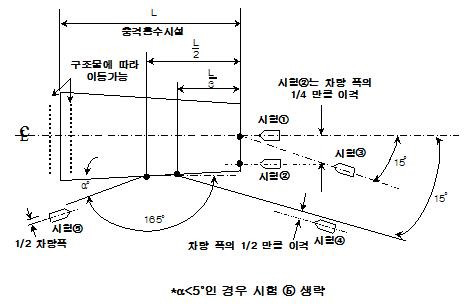
-
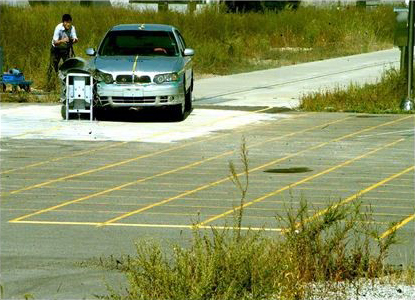
165 degrees side impact
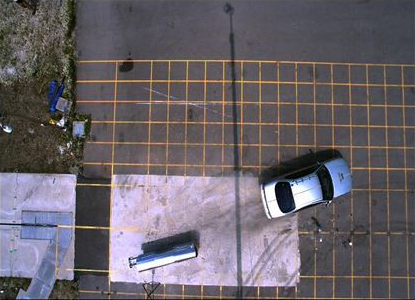
15 degrees side impact
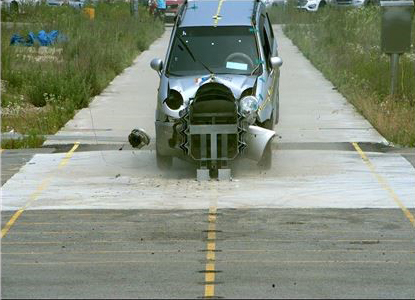
front impact
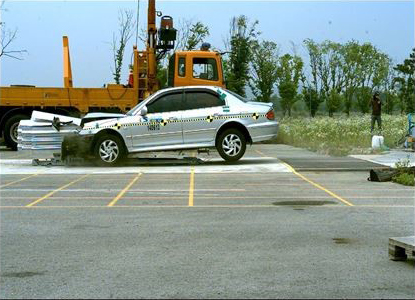
15 degrees front impact
- B. Performance Evaluation Standards
충돌차량의 충돌위치 및 충돌방향 성능평가 기준에 대한 표로써 측정항목, 기 준 항목으로 구성됩니다. Measured Items Standards Passenger Protection Function Theoretical Head Impact Velocity (THIV) ≤44km/h(Tests ①,②,③)
≤33km/h(Tests ④,⑤)Post-impact Head Deceleration (PHD) ≤20g (g=9.8m/s2) ASI (Reference value) Shock absorber behavior Facility shall not penetrate internal space of vehicle There shall be no displacement within internal space of vehicle that may severely injure passengers Key part of facility shall not be disassembled or cross into nearby lanes
- Rating classification according to level of deformity in shock absorber
(D1: Below 0.5m, D2: Below 1.0m, D3: Below 2.0m, D4: Below 3.0m, D5: Exceeds 2.0)Vehicle behavior after impact Vehicle roll and pitch after impact shall each be below 75° and it should be standing on the ground surface Crash vehicle shall not approach the protected structure head-on Wheel of vehicle shall not step over the virtual boundaries of bugout box that is distanced at a certain length from the perimeter of facility
(However, exception is made when boundary approach speed is below 10% of crash speed)Rating classification according to scope of vehicle bugout
(Z1: Below 4m, Z2: Below 6m, Z3: Exceeds 6m)※ THIV : Theoretical Head Impact Velocity ※ PHD : Post-impact Head Deceleration ※ ASI : Acceleration Severity Index
TMA
Impact Position and Direction for Crash Vehicle
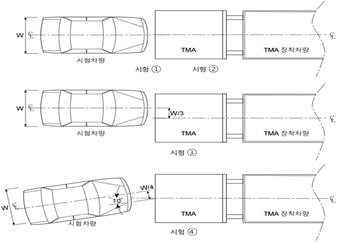
- A. Performance Test Conditions
충돌차량의 충돌위치 및 충돌방향 성능시험 조건에 대한 표로써 시험등급, 충돌속도, 차량중량, 충돌방법, 충돌방향 항목으로 구성됩니다. Test Rating Impact velocity (km/h) Vehicle weight (kg) Collision method Collision direction TMA1 60 900 Test ① Center front 1,300 Test ② Center front Test ③ (Optional) 1/3W offset front Test ④ (Optional) 1/4W offset 10° TMA2 80 900 Test ① Center front 1,300 Test ② Center front Test ③ (Optional) 1/3W offset front Test ④ (Optional) 1/4W offset 10° TMA3 100 900 Test ① Center front 1,300 Test ② Center front Test ③ (Optional) 1/3W offset front Test ④ (Optional) 1/4W offset 10° ※ Footnote 1) TMA : Truck Mounted Attenuator ※ Footnote 2) Impact test method shall satisfy Tests ①~④ by principle but it can be used as TMA when Tests ① and ② are satisfied considering current technology level
-
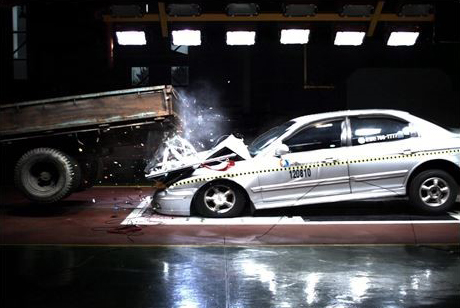
2.5-ton truck TMA impact test
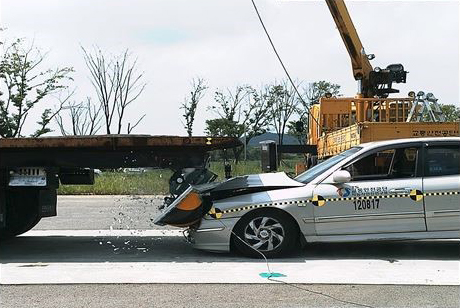
10-ton truck TMA impact test
- B. Performance Evaluation Standards
TMA 성능평가 기준에 대한 표로써 측정항목, 기 준 항목으로 구성됩니다. Measured Items Standards Passenger Protection Function Theoretical Head Impact Velocity (THIV) ≤44km/h Post-impact Head Deceleration (PHD) ≤20g (g=9.8m/s2) ASI 1.9 TMA behavior Facility shall not penetrate internal space of vehicle There shall be no displacement within internal space of vehicle that may severely injure passengers Composition material above 2kg shall not break away No material shall cross into nearby lanes Vehicle behavior after impact Vehicle roll and pitch after impact shall each be below 75° and it should be standing on the ground surface Crash vehicle shall not approach the protected structure head-on ※ THIV : Theoretical Head Impact Velocity ※ PHD : Post-impact Head Deceleration ※ ASI : Acceleration Severity Index